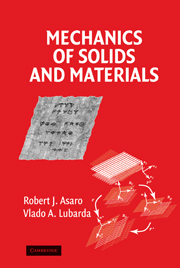Book contents
- Frontmatter
- Contents
- Preface
- PART 1 MATHEMATICAL PRELIMINARIES
- PART 2 CONTINUUM MECHANICS
- PART 3 LINEAR ELASTICITY
- PART 4 MICROMECHANICS
- PART 5 THIN FILMS AND INTERFACES
- PART 6 PLASTICITY AND VISCOPLASTICITY
- 26 Phenomenological Plasticity
- 27 Micromechanics of Crystallographic Slip
- 28 Crystal Plasticity
- 29 The Nature of Crystalline Deformation: Localized Plastic Deformation
- 30 Polycrystal Plasticity
- 31 Laminate Plasticity
- PART 7 BIOMECHANICS
- PART 8 SOLVED PROBLEMS
- Bibliography
- Index
27 - Micromechanics of Crystallographic Slip
Published online by Cambridge University Press: 06 July 2010
- Frontmatter
- Contents
- Preface
- PART 1 MATHEMATICAL PRELIMINARIES
- PART 2 CONTINUUM MECHANICS
- PART 3 LINEAR ELASTICITY
- PART 4 MICROMECHANICS
- PART 5 THIN FILMS AND INTERFACES
- PART 6 PLASTICITY AND VISCOPLASTICITY
- 26 Phenomenological Plasticity
- 27 Micromechanics of Crystallographic Slip
- 28 Crystal Plasticity
- 29 The Nature of Crystalline Deformation: Localized Plastic Deformation
- 30 Polycrystal Plasticity
- 31 Laminate Plasticity
- PART 7 BIOMECHANICS
- PART 8 SOLVED PROBLEMS
- Bibliography
- Index
Summary
Fundamental concepts concerning the micromechanics of crystalline plasticity are reviewed in this chapter. An overview of deformation mechanisms is given for crystalline materials that possess grain sizes that are said to be “traditional,” i.e., larger than about 2 µm in diameter. Some brief comments are made about the trends in deformation mechanisms when the grain sizes are much below this range (nanograins).
Early Observations
In a series of articles published between 1898 and 1900 Ewing and Rosenhain summarized their metallographic studies of deformed polycrystalline metals. The conclusion they reached concerning the mechanisms of plastic deformation provided a remarkably accurate picture of crystalline plasticity. Figure 27.1 is a schematic diagram, including some surrounding text, taken from their 1900 overview article. Figure 27.2 is one of their many excellent optical micrographs of deformed polycrystalline metals; the particular micrograph in Fig. 27.2 is of polycrystalline lead. They identified the steps a-e in Fig. 27.1 as “slip-steps” caused by the emergence of “slip bands,” which formed along crystallographic planes, at the specimen surfaces (thereby coining these two well-known phrases).
Traces of the crystalline slip planes were indicated by the dashed lines. The line labeled C was indicated by them to be a grain boundary separating two grains; the grains, they concluded, were crystals with a more or less homogeneous crystallographic orientation. Slip steps corresponding to the diagram of Fig. 27.1 are clearly visible in the micrograph of Fig. 27.2.
- Type
- Chapter
- Information
- Mechanics of Solids and Materials , pp. 502 - 537Publisher: Cambridge University PressPrint publication year: 2006



